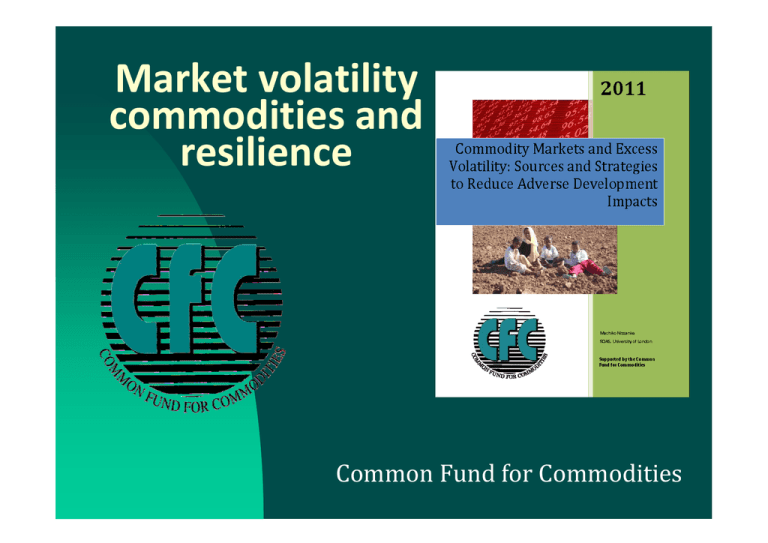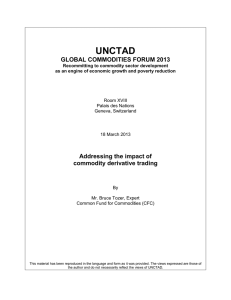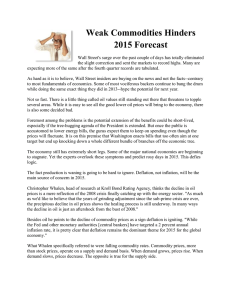Market volatility commodities and resilience Common Fund for Commodities
advertisement

Market volatility commodities and resilience Common Fund for Commodities Historical perception of the role of commodities in development of LDCs Core issues: Historically commodity prices depressed with occasional spikes Declining ToT for commodities Rising volatility Impact on CDDCs: Dutch disease (e.g. Sachs and Warner) Political failures (Collier) Volatility a distinct issue (Nissanke, v.d. Ploeg) The changing world I : New balance of economic power The income pyramid and new markets Area Population 2015 Population 2050 China 1418 1789 India 1212 1822 Russia 143 182 Indonesia 260 409 USA 308 310 EU 15 380 385 Brazil 201 288 Tier 1 >$20,000 75-100 mil Tier 2 & 3 $1500-$20,000 1.7 bil. Tier 4 <$1500 4+ bil. * By D.P de Boer, Sustainable Development Centre - MSM 3/15/2012 Common Fund for Commodities 3 Global GDP and population Year 1000 80 80 70 70 60 60 50 50 % % Year 0001 40 40 30 30 20 20 10 10 0 0 Asia China Share GDP India Western Europe North America Asia China Share Population India Share GDP Western Europe North America Share Population Year 1969 Year 1820 60 80 70 50 60 40 % 50 40 30 30 20 20 10 10 0 Asia China Share GDP India Western Europe North America 0 Asia China Share Population India GDP Source: Kaplinsky, Farooki, 2011 Europe Population N America Historical change Over recent 50 years commodity prices depressed, with occasional spikes Prebisch-Singer hypothesis: commodity prices decline relative to manufactures About to change? Source: Nissanke, 2010 The changing world II: Financialization The changing world III: In search of new paradigm Entering an era of expensive commodities, or volatile commodities, or both Something to worry about Market volatility and its effects on development: income redistribution Volatility as development issue: in brief Commodity markets are inherently volatile. Market prices carry information essential for market efficiency Strong link with financial markets introduces financial volatility beyond fundamentals Economic cost of volatility is not shared evenly across VC. Weakest players pay the most to lay off the volatility risk Vulnerability to volatility: the cost of market volatility to LDCs is higher than other countries A DEVELOPMENT PROBLEM Commodity dependence as symptom Commodity dependence is not a curse, a symptom of lack of development opportunities, Particularly a symptom of failure to industrialize Countries showing commodity dependence need to focus on addressing the reasons for absence of opportunities and develop core competences and competitive advantage Defining commodity dependence May need a meaningful definition; simplistic view of commodity dependence as % share confuses the issue Commodity dependence an underlying factor of economic vulnerability Managing commodity induced vulnerability essential for graduation from LDC status Issue is both structural and institutional Commodity dependence trap Pockets of persistent commodity dependence – evidence of a trap (Nissanke). Particularly affects LDCs Cause 1: macro and politics (Sachs and Warner, Colier) Overcoming requires investment in production capacity and diversification Cause 2: international economic architecture Globalized competitive environment not conducive to domestic savings FDI volatile and procyclical Large role for domestic policies and ODA in overcoming commodity trap Financial coping mechanisms probably overrated Specific case: CFC Cocoa pilot Successful pilot implementation of market based hedging strategies for cocoa producers in Cote d’Ivoire Four contracts carried out, no defaults, positive outcomes Instructive (CFC, Zant 2010): POPs cheaper, but problematic because default risk Straight options expensive, total cost 14% farmgate Options short duration Only feasible for largest best managed coops Alternative risk mitigation strategies effective General issues: Physical and Financial Physical Consumer Financial Market maker Intermediary Producer Arbitrage Risk taker Hedger Leveraging for take-off … 1mln of coffee contracts used as collateral @100c 1 contract trades @ 101c Collateral re-valued, created extra $10,000 Overcollateralized, must re-balance portfolio, buy $10,000 more coffee Prices climb again In financial markets, price variations cause variations in market liquidity . Liquidity moves prices. Market trends become self-reinforcing. … and crash. Propagation of a financial shock 1. An investor needs money – sells commodities futures position. Futures price declines 2. Arbitrageur sees income opportunity: offers cut-price futures to the consumer 3. Producer drops the price to sell physical stock 4. Consumer sees downward trend in price: POSTPONES THE PURCHASES expecting lower price 5. Arbitrageur sees increasing uncertainty of demand: imposes LIQUIDITY DISCOUNT Nuanced empirical evaluation finds some evidence of excess volatility transmisson Liquidity perspective Liquidity is a major determinant of market price. Prices in ideal markets are driven by information. Prices in financial markets are driven by liquidity and expectations Liquidity premiums (cost of liquidity) is determined by arbitrageurs in response to liquidity demand Primary producers are liquidity consumers. Liquidity costs rise with volatility. Commodity stocks less liquid than financial instruments, holders physical stock == commodity producers pay more to be liquid. Keep commodity markets for commodities? 1. Regulate commodities separately from finance 2. Restrict banks to banking functions • Implications, e.g. for over-the-counter trade, exchange-traded funds 3. Make the trade transparent • Regulator should publish transactions data 4. Restrict ‘non-commercial’ transactions 5. Stability and security Æ central clearing; position limits Part of general paradigm change for regulators, jury still out Source: T. Lines at CFC Conference in Brussels, 2010 To sustainable structural transformation Practical measures Market driven sustainability The economic impact of a value chains driven project is generated by the market, rather than by donor financing itself. The magnitude of the impact goes beyond donor financing. Production Design Marketing Knowledge Technologies Commodities 3/15/2012 Common Fund for Commodities 21 Focus on core competences Social and economic equity Training and Jobs Communication and transparency Community involvement “Big oil should help small business” LINKAGES to allow economic growth to trickle down CASE 1. Biogas co-generation from sisal waste Hard fibre – relatively low income Large quantities of effluent a major constraint: 24 tonnes of waste to 1 tonne of fibre Decomposes to methane – high GHG impact Treatment of effluent uneconomical Sisal biogas – economics of co-generation* 1,200 ha ==130 m3 fresh sisal per day === 500 KW of electricity. Assuming 10% electricity use for own consumption sell 90% Revenue estimated 70-100% of extra revenue on sisal fibre sales. *data of Tanzania Sisal Board Sisal biogas: ingredients Information to identify the opportunity; Technical knowledge and skills Access to capital Regulatory support - opening up of electricity market Challenge - document the experience and facilitate further investment where economically feasible CASE 2: cassava as industrial raw material • • • • • Rootcrop with high yield in tropical conditions and high nutritional value Suffers from PPD – perishable within 24 hours Traditional processing does not retain quality for industrial use Technology known for high quality primary processing Challenge: to facilitate emergence of industrial value chains using cassava Photo: I. Moreno (ETH Zurich) Mechanised processing of cassava Village level == USD1,500 Peel Grate Wash and press Primary drying Secondary processing == USD30,000 Transport to processing centre Flash drying Milling Packaging High Quality Cassava Flour FORWARD linkages: • Cost ~70% of wheat • Substitutes: •10% in bread • 50% in cookies • 100% for in starch industry BACKWARD linkages: • much of processing equipment can be manufactured locally • creates demand for high value skills in quality control and production management CASE 3: Industrialization of storage through warehouse receipts Reliable storage essential in marketing seasonal crops Expensive – mostly private storage by trading companies. Farmers sell at low price Farmers face tradeoff – onfarm storage and quality loss, or sell to trader at harvest and lose because low price Opportunity: income from seasonal price fluctuations Challenge: facilitate creation of regulated public warehousing as industry separate from trader companies Warehouse Receipt Cycle 1. Grain producer brings grain to the certified warehouse 5. Warehouse unloads grain to the mill. Grain PC 1 PC Grain TC 5 TC TC 3 3. Producer sells grain to the mill Grainproducer Grain Processor - mill PC PC Loan 2. The Bank gives the loan to the Producer under the pledge of Grain. 2 4 Common Fund for Commodities © local bank 2002 Loan + interest 4. The mill repays the loan to the Bank Warehouse receipt: practical example Receiving clerk Weighting and tally Supervisor 3/15/2012 Common Fund for Commodities 32 Certifying a warehouse 3/15/2012 Common Fund for Commodities 33 Warehouse receipts: ingredients Goal is to create pre-conditions for the use of warehouse receipts: setting the standards; organizing sector stakeholders; supporting warehouse certification; capacity building; regulatory support - warehouse legislation. Tanzania Warehouse Licensing Board registered 38 warehouses, TSh 350bn in loans issued against warehouse receipts For an intervention to work in commodity sector: Commodity sector is experienced, large and powerful Identification of opportunities and targeting of intervention at the problem causes; leave the consequences to markets Access to capital; Access to technical knowledge; Regulatory support. Obtaining capital to invest retained profits. Should be major source. However, risk perception and lack of information limit investment; ODA. This is in the hands of international agencies, but need clear understanding of value chains to create assets, rather than liabilities for recipients; FDI. This has mixed effects, and there's evidence that short-term FDI may be destabilizing for commodity economies, undermining sustained industrial development. What matters first: NOT the scale, but Precise targeting of interventions against constraints: Production Marketing Capacity and capability Financing small and scattered farm units transportation human and institutional inappropriate funding mechanisms risk management storage packaging and branding organizational support and development reluctance of commercial banks to finance agriculture quality grades and standards technical and managerial expertise lack of favourable policy for agricultural financing advocacy skills lack of venture capital consistency of supply access to correct inputs support services planning and information services 3/15/2012 Common Fund for Commodities 37 CFC: What we do Operational since the early 90’s. We celebrated our 20th anniversary in 2009 CFC approved some 300+ projects with total cost of USD 560mln, of which the Fund financed USD 290mln The CFC carries out: Identification Screening Formulation Appraisal, and Identification of co-financiers 3/15/2012 Common Fund for Commodities 38 Common Fund for Commodities For further details please consult www.common-fund.org






